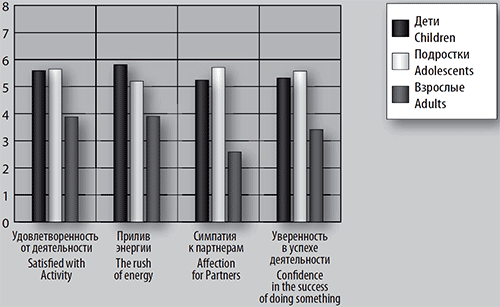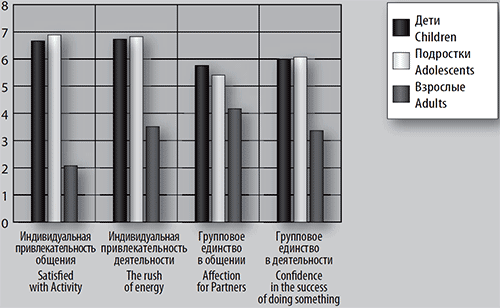Article
Devishvili V.M., Mdivani M.O., Elgina D.S. (2017). Group cohesion in sports teams of different professional level. National Psychological Journal, 4, 121–128
Abstract
Background. Team sports are not only the most exciting sporting events. but also complex activities that make serious demands on players. The effectiveness of the team depends not only on the high level of gaming interaction. but also on the relationship between the players. The work is based on the material of sports teams and is devoted to the study of the phenomenon of group cohesion. As a basic model. the authors choose a 4-factor model that describes cohesion in sports teams. The paper also considered the phenomenon of the emergence of the aggregate subject in the process of joint activity. when the participants feel themselves as a whole and experience feelings of satisfaction and a surge of energy.
Objective. The main objective of the work is to investigate the relationship between the level of team cohesion and subjective feelings of unity of its players. As additional variables in the study there is a sport (football and volleyball) and team level (amateur and professional).
To test the assumptions. two methods were used (the Sport Team Cohesion Questionnaire and the Subject Unity Index). which allow not only to determine the overall level of cohesion and unity. but also to reveal the structure of both phenomena. The study involved two men’s volleyball and two men’s football teams of different ages: 8-9 years (39 athletes); 12-14 years (24 athletes) and 18-25 years (41 athletes).
Design. For amateur groups represented by children’s and teenage sports teams. significant correlations between unity and unity were obtained (r = 0.618. p <0.01; r = 0.477. p <0.05). For professional teams. no significant correlations were found. Influence of the sport on cohesion is also different for amateur and professional teams. In the first case. the cohesion is higher for football players (U = 118. p <0.05). and in the second case for volleyball players (U = 124. p <0.05).
Results. The findings indicate that the professional level of players affects group cohesion and the phenomenon of group unity. The authors explain this by the fact that for professionals the main motive of the activity is to receive a reward for the game. and for the amateurs - the pleasure from joint actions.
Accepted: 08/23/2017
Pages: 121-128
DOI: 10.11621/npj.2017.0412
PDF: Download
Keywords: cohesion of the group; cohesion of the sports team; subject; subject-subject interaction; level of subjective unity; amateur and professional teams; kind of sport; sport psychology;
Available Online 01.01.2018
Table. 1. Coefficients of rank correlation between the subjective unity index and the group cohesion in children. adolescents and adults.
|
Children |
Correlation Coefficient |
0,618 |
|
Two-tailed significance |
0 |
|
|
N |
39 |
|
|
Adolescents |
Correlation Coefficient |
0,477 |
|
Two-tailed significance |
0,018 |
|
|
N |
24 |
|
|
Adults |
Correlation Coefficient |
0,15 |
|
Two-tailed significance |
0,35 |
|
|
N |
41 |
Table. 2. Coefficients of rank correlation between the scales of group cohesion and the factors of the subjective unity index in children (statistically significant correlations are in italics)
|
|
Satisfied with Activity |
The rush of energy |
Affection for Partners |
Confidence in the success of doing something |
|
Individual appeal of communication |
0.478 |
0.351 |
0.440 |
0.207 |
|
Individual appeal of activity |
0.262 |
0.266 |
0.174 |
.527 |
|
Group unity in communication |
0.281 |
0.181 |
0.07 |
0.299 |
|
Group unity in communication |
0.422 |
0.099 |
0.416 |
0.309 |
Table. 3. Coefficients of rank correlation between the scales of group cohesion and factors of the subjective unity index in adolescents (statistically significant correlations are in italics)
|
|
Satisfied with Activity |
The rush of energy |
Affection for Partners |
Confidence in the success of doing something |
|
Individual appeal of communication |
0.422 |
0.472 |
0.082 |
0.141 |
|
Individual appeal of activity |
0.3 |
0.564 |
0.004 |
0.234 |
|
Group unity in communication |
0.312 |
0.541 |
0.264 |
0.214 |
|
Group unity in communication |
0.282 |
0.507 |
0.405 |
0.274 |

Fig. 1. The factors of the subjective unity index in teams of different professional level

Fig. 2. The group cohesion scales in the teams of different professional level
References:
Bea,. D J.; Cohen, R.; Burke, M.J. & McLendon, C. L. (2003) Cohesion and performance in groups: A meta-analytic clarification of construct relation. Journal of Applied Psychology, 88 (6), 989–1004. doi: 10.1037/0021-9010.88.6.989
Benson, A.J., Šiška. P., Eys, M., Priklerovád, S. & Slepičkab, P. (2016) A prospective multilevel examination of the relationship between cohesion and team performance in elite youth sport. Psychology of Sport and Exercise, 27, 39–46. doi: 10.1016/j.psychsport.2016.07.009
Bosselut, G.. McLaren, C.D., Eys, M.A. & Heuzé, J.P. (2012). Reciprocity of the relationship between role ambiguity and group cohesion in youth interdependent sport. Psychology of Sport and Exercise, 13, 341–348. doi: 10.1016/j.psychsport.2011.09.002
Bruner, M.W., Eys, M.A., Beauchamp, M.R.. & Côté, J. (2013) Examining the origins of team building in sport: A citation network and genealogical approach. Group Dynamics: Theory. Research. and Practice, 17, 30–42. doi: 10.1037/a0030114
Bruner, M.W. & Spink, K.S. (2010) Evaluating a team building intervention in a youth exercise setting. Group Dynamics: Theory. Research. and Practice, 14, 304–317. doi: 10.1037/a0018296
Brushlinsky, A.V. (2003) The psychology of the subject. St. Petersburg. Aleteya, 272.
Carron, A.V. & Brawley, L.R. (2000) Cohesion: Conceptual and measurement issues. Small Group Research, 31(1), 89–106. doi: /104649640003100105
Carron, A.V., Widmeyer, W.N. & Brawley, L.R. (1985) The development of an instrument to assess cohesion in sport teams: The Group Environment Questionnaire. Journal of Sport Psychology, 7, 244–266. doi: 10.1123/jsp.7.3.244
Cota, A.A.; Evans, C.R.; Dion, K.L.; Kilik, L. & Longman, R.S. (1995) The structure of group cohesion. Personality and Social Psychology Bulletin, 21(6), 572–580. doi: /10.1177/0146167295216003
Dunn, J. G. H., & Holt. N. L. (2004) A qualitative investigation of a personal-disclosure mutual-sharing team building activity. The Sport Psychologist, 18, 363–380. doi: 10.1123/tsp.18.4.363
Heuze, J.P., Raimbault, N., & Fontayne, P. (2006) Relationships between cohesion. collective efficacy and performance in professional basketball teams: an examination of mediating effects. J. Sports Sci, 24(1), 59–68. doi: 10.1080/02640410500127736
Gillespie, A. (2005) G.H. Mead: Theorist of the social act. Journal for the Theory of Social Behaviour, 35, 19–39. doi: 10.1111/j.0021-8308.2005.00262.x
Eys. M.. Loughead. T.. Bray. S.R.. & Carron. A.V. (2009). Development of a cohesion questionnaire for youth: The Youth Sport Environment Questionnaire. Journal of Sport & Exercise Psychology, 31, 390–408. 0.1123/jsep.31.3.390
Festinger. L. (1954) A Theory of Social Comparison Processes. Human Relations, 7, 117–140. doi: 10.1177/001872675400700202
Filho, E.. Dobersek, U.. Gershgoren, L, Becker, B. & Tenenbaum, G. (2014) The cohesion-performance relationship in sport: A 10-year retrospective meta-analysis. Sport Sciences for Health, 10, 165–177. doi: 10.1007/s11332-014-0188-7
Folkes, V.S. (1982) Forming relationships and the matching hypothesis. Personality and Social Psychology Bulletin. 8, 631–636. doi: 10.1177/0146167282084005
Forsyth, D.R. (2010) Components of cohesion. Group Dynamics. 5th Edition. Wadsworth. Cengage Learning, 118–122.
Lundgren, D.C. (2004) Social feedback and self-appraisals: Current status of the Mead-Cooley hypothesis. Symbolic Interaction, 27, 267–286. doi: 10.1525/si.2004.27.2.267
Mdivani, M.O. (2015) Index of subjective unity: to the development of methodology: the theses of the 7th Russian Conference on ecopsychology. September 28–29, 2015. St. Petersburg. Nestor-Istoriy, 118–119.
Mdivani, M.O., Devishvili, V.M. & Korneev, I.S. (2013) The cohesion of the sports team and the communicative structure of the group. [Sportivnyy psikholog], 3(30), 14–18.
Mdivani, M.O. & Markov, A.S. (2015) Subjective interactions in cohesive collectives. [Rossiyskiy nauchnyy zhurnal], 3, 167–173.
Nemov, R.S. (2003) Interpersonal relations in groups and collectives. Moscow. VLADOS, 688.
Panov, V.I. (2013) Ecopsychological interactions: types and typology. [Sotsial’naya psikhologiya i obshchestvo], 3, 13–27.
Petrenko, V.F. (1997) Fundamentals of psychosemantics. Moscow. MGU, 400.
Petrovsky, A.V. (1982) Personality. Activity. Team. Moscow. Politizdat, 255.
Petrovsky, V.A. (1992) Psychology of non-adaptive activity. Moscow. Gorbunok, 224.
Sidorenkov, A.V. (2005) An analysis of the research of small groups in Russian psychology on publications in the journals «Questions of Psychology» and «Psychological Journal». [Voprosy psikhologii], 2, 58–67.
Turner, D. (2003) Social influence. St. Petersburg. Piter, 256.
Turner, J. & Giles, H. (1981) The experimental social psychology of intergroup behavior. Intergroup Behaviour. Oxford, 66–101.
Vachkov, I.V. (2014) Polysubject interaction in the educational environment. [Psikhologiya. Zhurnal Vysshey shkoly ekonomiki], 11( 2), 36–50.
For citing this article:
Devishvili V.M., Mdivani M.O., Elgina D.S. (2017). Group cohesion in sports teams of different professional level. National Psychological Journal, 4, 121–128


